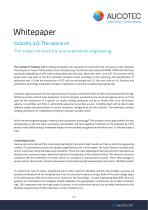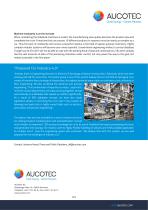 Website:
AUCOTEC
Website:
AUCOTEC
Catalog excerpts

Whitepaper Industry 4.0: The race is on The impact on electrical and automation engineering The concept of "Industry 4.0" is setting completely new standards for production and will cause a major upheaval from the point of view of both products and manufacturing. The German associations BITKOM, VDMA and ZVEI have specifically established an office which deals solely with this topic. What then were 1.0 to 3.0? The invention of the power loom was seen as the first industrial revolution while, according to this reckoning, the electrification of production was 2.0 and the introduction of PLC and bus technology was 3.0. We now come to 4.0. Electrical and automation technology will greatly increase in importance, as will the corresponding engineering. Instead of rigid production lines for large volumes of a product, individual orders will then be processed with the high efficiency and low costs of mass production. Thus, for example, a production line would no longer be set up, as in the past, for the construction of a specific car model. Instead, production will be so flexible that a line will produce saloons, convertibles and SUVs in alternating sequence, but as fast as ever. A bottling plant will be able to take different recipes and decant them to various containers, configured to suit the customer. This eliminates complex building conversions or modifications whenever a product variation arises. What role does engineering play in electrical and automation technology? This question can be approached from two perspectives: on the one hand, increasing customisation will have significant influence on the engineering of the product itself, whilst having considerable impact on the manufacturing plants on the other hand. To take the product view: Customisation wins Here we are concerned with the customised planning of the product itself, insofar as it has an electrical engineering content. The automotive industry has already progressed very far in this respect. The major German manufacturers rely on customised wiring harnesses and modularity. This is the major advantage of German premium manufacturers because their customers expect absolute freedom in the assembly of their desired vehicle. This diversity cannot be compared with the predefined trim levels which, for example, US manufacturers provide. There, they manage to produce about 150 variants, while the advocates of customised wiring harnesses give rise to some 100,000 variants! To achieve this level of choice, engineering has to offer maximum flexibility and the best possible overview. All possible combinations of the wiring harness must be conceived in advance using a draft of the entire design space in the planning tool, after which they can be reduced to the final design - as with Engineering Base (EB). Here, the graphics are connected to an intelligent, flexible database. This guarantees a continuously up-to-date connection logic. EB's experience with the huge range of variation in the automotive industry can be easily transferred to the flexibility requirements of other industries in terms of Industry 4.0.
Open the catalog to page 1
The manufacturing view: The second field that is facing striking changes is mechanical and plant engineering. Lines with increasing robotics content and highly flexible manufacturing cells will become prevalent to enable manufacture of "lot size 1" at the same rate as mass production. Recognising geometries and the information contained in the blank and responding to them within fractions of a second requires any number of sensors and actuators to be planned and documented. Their intelligence will also increase. More complex data streams and more time-consuming control tasks demand a...
Open the catalog to page 2
Machine modularity is on the increase When considering the individual machines in a plant, the manufacturing view quickly becomes the product view and completes the circle: A machine that can process 10 different products in sequence must be nearly as complex as a car. Thus the topic of modularity will receive a powerful impetus in the field of special-purpose machinery. Highly complex modular systems will become even more essential. Conventional engineering without a central database ("single source of truth") will not be able to cope with the pending flood of data and combinatorics. EB,...
Open the catalog to page 3All AUCOTEC catalogs and technical brochures
-
EVU
53 Pages
-
ELCAD
9 Pages
-
ELCAD brochure
9 Pages
-
RUPLAN
8 Pages
-
AUCOPLAN
10 Pages
-
Engineering Base
6 Pages













